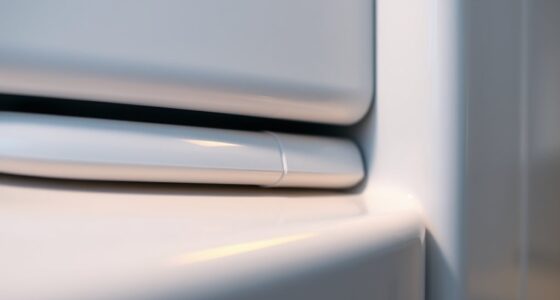An induction cooktop uses electromagnetic energy to heat your cookware directly instead of warming the cooktop itself. Beneath the surface, a copper coil generates a magnetic field that interacts with compatible cookware, like cast iron or certain stainless steels, inducing electric currents that create heat. This method transfers up to 90% of energy to your cookware, making it far more efficient than traditional electric or gas stoves. Plus, the cooktop surface remains cool, greatly reducing burn risks. If you're curious about the benefits and considerations of using induction technology, there's more to discover.
Key Takeaways
- Induction cooktops use electromagnetic energy to generate heat directly in induction-compatible cookware through a magnetic field created by coiled copper wire.
- Compatible cookware must be made from magnetic materials like cast iron or certain stainless steels; a magnet test can verify this.
- Induction cooking is highly efficient, transferring up to 90% of energy to cookware, significantly outperforming traditional gas and electric methods.
- The cooktop surface remains cool during cooking, drastically reducing burn risks and enhancing safety with features like automatic shut-off.
- Rapid heat adjustments allow for precise cooking control, enabling faster cooking times and improved meal preparation efficiency.
What Is Induction Cooking?
Have you ever wondered how induction cooking works? Induction cooking is a modern and innovative method that uses electromagnetic energy to heat cookware directly. When you turn on an induction cooktop, it generates a magnetic field through a copper coil hidden beneath the surface. This magnetic field induces electric currents in compatible cookware, like cast iron or stainless steel, producing heat without warming the cooktop itself.
One of the main advantages of induction cooking is its energy-efficient nature. It transfers up to 90% of the energy directly to your cookware, compared to around 70% for gas stoves and about 65% for traditional electric ones. This efficiency not only saves energy but also allows you to heat your food quickly—boiling water, for instance, can take just 2-4 minutes faster than on conventional cooktops.
Moreover, with induction cooking, you gain precise temperature control, so you can easily adjust the heat to suit your cooking needs.
Plus, because the cooktop surface remains cool to the touch, it markedly reduces the risk of burns, making your kitchen a safer place to cook.
How Induction Cooking Works
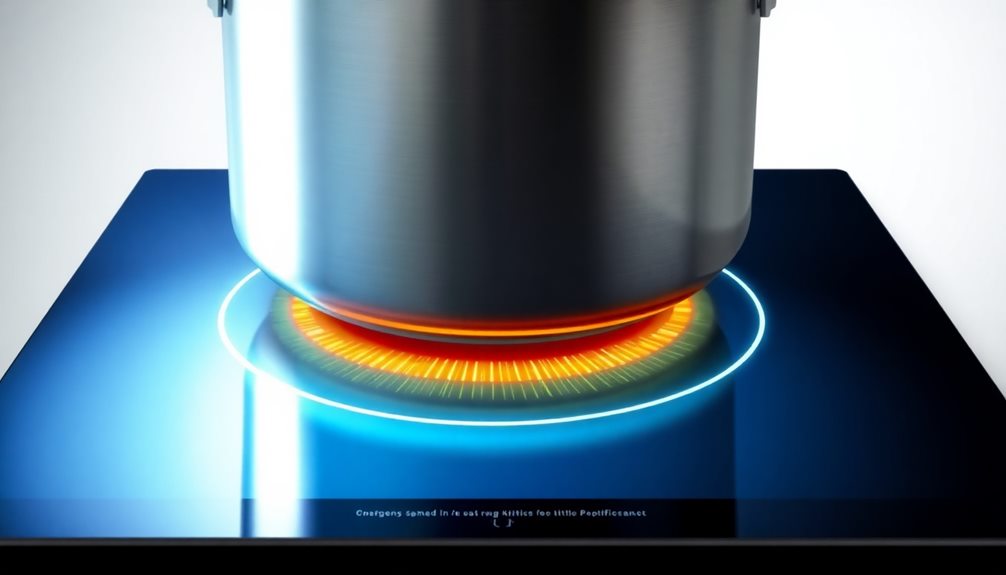
Induction cooking operates on the principle of electromagnetic energy, which sets it apart from traditional cooking methods. Induction cooktops generate a magnetic field using coiled copper wire beneath the surface, interacting directly with induction-compatible cookware. This magnetic energy induces electric currents in your pots and pans, producing heat right where you need it—in the cookware itself.
Here are a few benefits of this innovative cooking technology:
- Faster Cooking: You'll notice that water boils 2-4 minutes faster than on gas or electric cooktops, thanks to efficient energy transfer.
- Precise Temperature Control: Adjusting the heat is instantaneous, allowing you to achieve the desired cooking temperature with accuracy and consistency.
- Cooler Cooking Surface: The cooktop remains cool to the touch when no cookware is present, considerably reducing the risk of burns, making your kitchen safer.
With induction cooking, you're not just upgrading your kitchen; you're embracing a smarter and more efficient way to prepare meals.
Experience the future of cooking with induction cooktops, where heat is generated directly in the cookware for ideal results.
Benefits of Induction Cooking
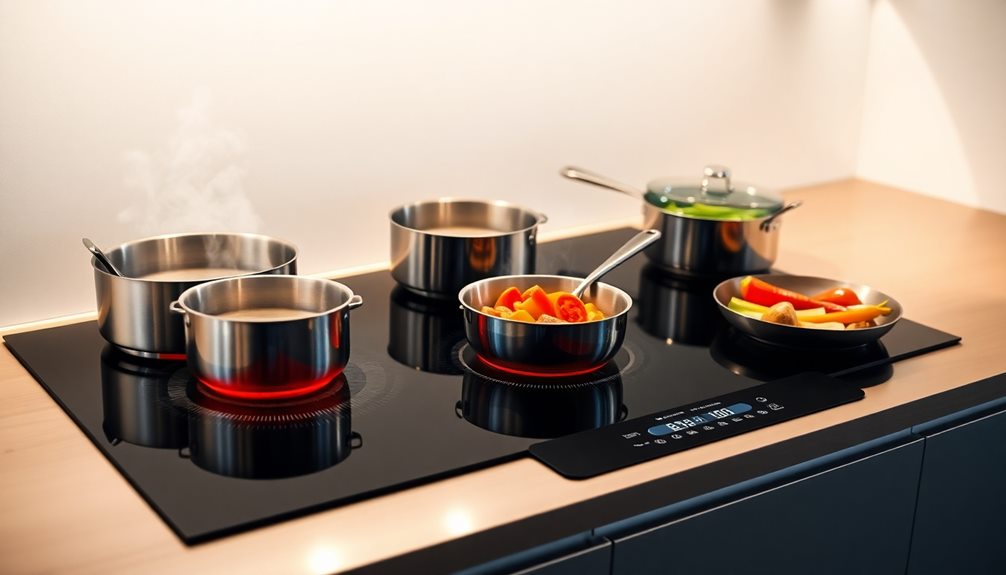
When you switch to induction cooking, you'll notice just how much faster your meals come together.
With its impressive energy efficiency and easy cleanup, induction cooktops make cooking not only quick but also hassle-free.
Plus, you can enjoy the peace of mind that comes with precise temperature control and a cool-to-touch surface.
Faster Cooking Times
Cooking with induction cooktops not only saves you time but also enhances your overall culinary experience. You'll appreciate the faster cooking times that induction technology offers. With its direct energy transfer method, induction cooktops can boil water in just 2-4 minutes, making meal prep a breeze.
Here are some benefits you can enjoy:
- Quicker Cooking: Induction cooking times are 25-50% faster than traditional methods, allowing you to whip up meals in no time.
- Immediate Heat Control: You can adjust the heat instantly, giving you precise control for rapid searing and boiling without waiting for the cooktop to heat up.
- Cool-to-Touch Surface: The cool surface minimizes heat loss, enhancing energy efficiency and allowing for quicker cooking without worrying about burns from residual heat.
With induction cooking, you'll experience rapid boiling and consistent simmering, reducing the chances of overcooking or scorching your food.
Embrace the future of cooking, where faster cooking times make your kitchen experience enjoyable and efficient!
Easy Cleanup Process
The ease of cleanup is one of the standout benefits of using an induction cooktop. Thanks to their smooth, flat surfaces, these cooktops are easy to wipe, allowing you to tackle food spills without hassle. Because the cooktop surface remains cooler during cooking, spills don't adhere as easily, making your cleanup quicker and more efficient.
Induction cooktops heat evenly through direct contact with the cookware, which means food spills are less likely to scorch on the surface. This reduces the need for extensive scrubbing later on. Many induction models also feature a seamless design, eliminating crevices where food can accumulate, further enhancing the ease of cleaning.
One of the best parts? You can clean up spills almost immediately without worrying about burns, thanks to the lack of residual heat on the cooktop. This means you can maintain a spotless kitchen without the stress of waiting for surfaces to cool down.
The combination of these features makes induction cooking not just efficient but also a breeze when it comes to cleanup, giving you more time to enjoy your delicious meals.
Energy Efficiency Advantages
Induction cooktops offer remarkable energy efficiency that can transform your cooking experience. These innovative appliances are designed to reduce energy waste while delivering exceptional performance. Here are a few standout benefits:
- Up to 90% energy efficiency: Induction cooktops transfer energy directly to induction-compatible cookware, far surpassing traditional stoves that can only achieve 40-75% efficiency. This means you'll save on energy bills over time.
- Faster cooking times: You'll notice that water boils 2-4 minutes quicker than with conventional methods. That means less waiting and more time enjoying your meals.
- Minimal residual heat: Since induction technology produces less residual heat, your kitchen stays cooler. This not only enhances comfort but can also lower your air conditioning costs during cooking.
With precise temperature control, induction cooktops allow for consistent simmering without excess energy loss, ensuring you utilize energy effectively.
Plus, their cookware compatibility means you can easily switch to induction without needing to replace all your pots and pans. Embracing induction cooking is a smart choice for a more energy-efficient and enjoyable cooking experience.
Key Features of Induction Cooktops
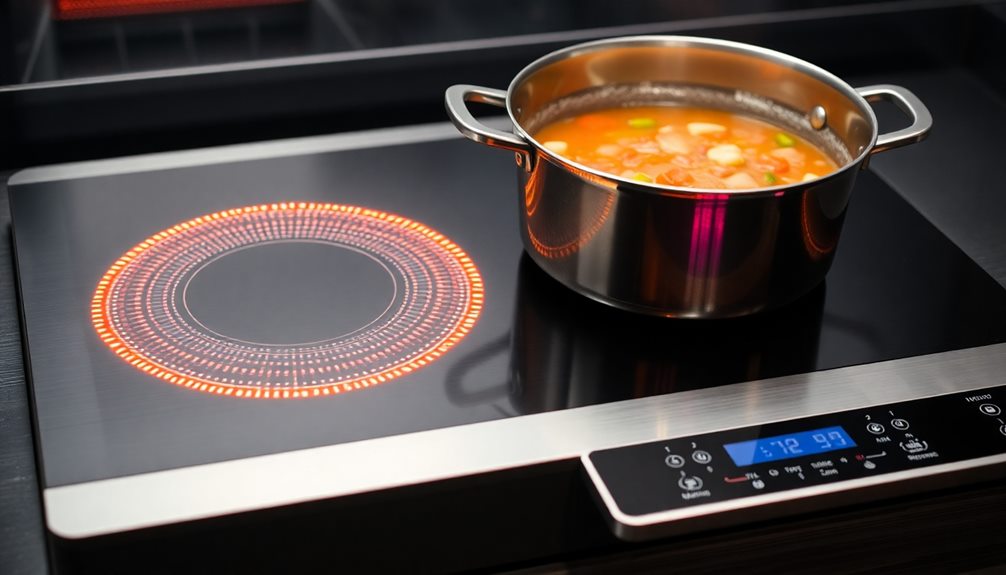
One of the standout features of induction cooktops is their ability to harness electromagnetic energy, allowing for incredibly fast and efficient cooking. This technology generates a magnetic field through a copper coil, which heats only compatible cookware, guaranteeing rapid cooking times and precise temperature control.
Since the heat is produced directly within the cookware, the cooking surface remains cool to the touch, markedly reducing the risk of burns and enhancing safety in your kitchen.
Many induction cooktop models come equipped with auto-sizing pan detection, which automatically adjusts the heat output based on the size of the cookware you place on the surface. This feature not only promotes efficient energy use but also guarantees that your meals are cooked evenly.
Additionally, induction cooktops offer responsive heat adjustments, giving you instant control similar to gas cooktops, making it easy to fine-tune your cooking.
Induction vs. Electric Cooktops
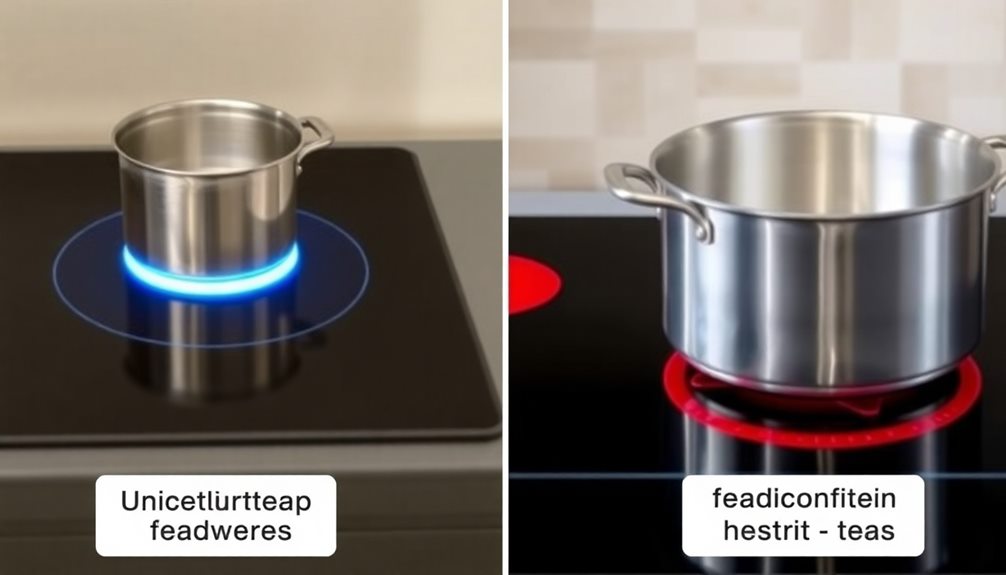
When weighing your cooking options, it's important to understand how induction cooktops stack up against traditional electric models. Induction cooktops utilize electromagnetic fields to create heat directly within your magnetic cookware, making them energy-efficient and faster in cooking.
In contrast, electric cooktops radiate heat from coils beneath their surface, providing indirect heat transfer.
Here's a quick comparison of the two:
- Efficiency: Induction cooktops are about 85% energy-efficient, while electric cooktops typically range from 70-75%. This means less wasted energy and quicker cooking times.
- Speed: With induction technology, you can boil water in just 2-4 minutes, markedly faster than electric methods.
- Safety: Induction cooktops remain cool to the touch when not in use, reducing the risk of burns. Electric cooktops can retain heat even after being turned off, posing a potential safety hazard.
Ultimately, if you prioritize speed, efficiency, and safety, induction cooktops may be the right choice for you.
However, remember to check your cookware compatibility, as not all materials work with induction technology.
Cookware Compatibility for Induction
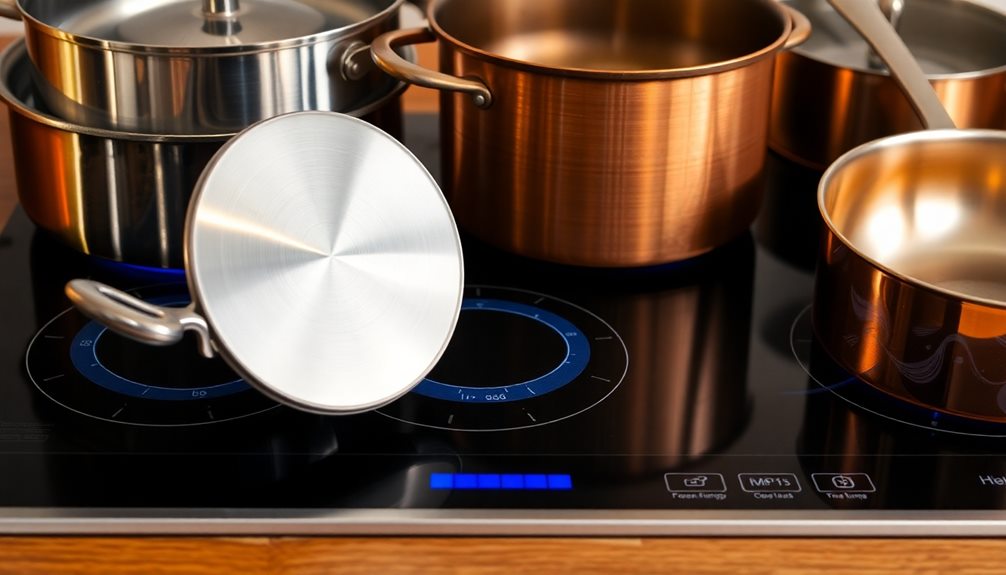
When it comes to using induction cooktops, your cookware needs to be made from magnetic materials like cast iron or certain stainless steels.
If you're unsure about your pots and pans, just grab a magnet; if it sticks, you're good to go.
Magnetic Material Requirements
Induction cooktops rely on specific cookware to function properly, so understanding the magnetic material requirements is essential. For your induction cooking to work effectively, you need cookware made from ferrous metals, such as cast iron or stainless steel. These materials are magnetic and can generate heat through induction, guaranteeing efficient cooking.
Here are three key points to remember about cookware compatibility:
- Magnet Test: Before using a pot or pan, perform a simple magnet test. If the magnet sticks to the bottom, it's suitable for induction cooking.
- Non-Ferrous Limitations: Cookware made from aluminum, copper, glass, or ceramic won't work on induction unless they've a magnetic base added.
- Auto-Sizing Features: Some induction cooktops come with auto-sizing pan detection, which adjusts heat output based on your cookware size, optimizing energy efficiency.
Using incompatible cookware can lead to no heat generation, resulting in longer cooking times or ineffective cooking.
Cookware Types Explained
Understanding cookware compatibility is essential for maximizing the efficiency of your induction cooktop. To effectively generate heat, you need cookware made from ferrous metals like stainless steel and cast iron. These materials can be magnetized, allowing a magnetic current to pass through and heat your food quickly.
When choosing pots and pans, verify they've a flat bottom; this helps maintain proper contact with the induction surface, enhancing energy transfer.
If you have cookware made from non-ferrous materials such as aluminum, glass, copper, or ceramic, they won't work unless they've been specially designed with a magnetic layer or base. A quick way to check compatibility is the magnet test: if a magnet sticks to the bottom of your cookware, it's induction compatible.
Additionally, some induction cooktops come equipped with auto-sizing pan detection technology, adjusting the heating zone based on the size of the cookware sitting on top. This feature not only optimizes efficiency but also helps prevent energy waste.
Safety Features of Induction Cooktops
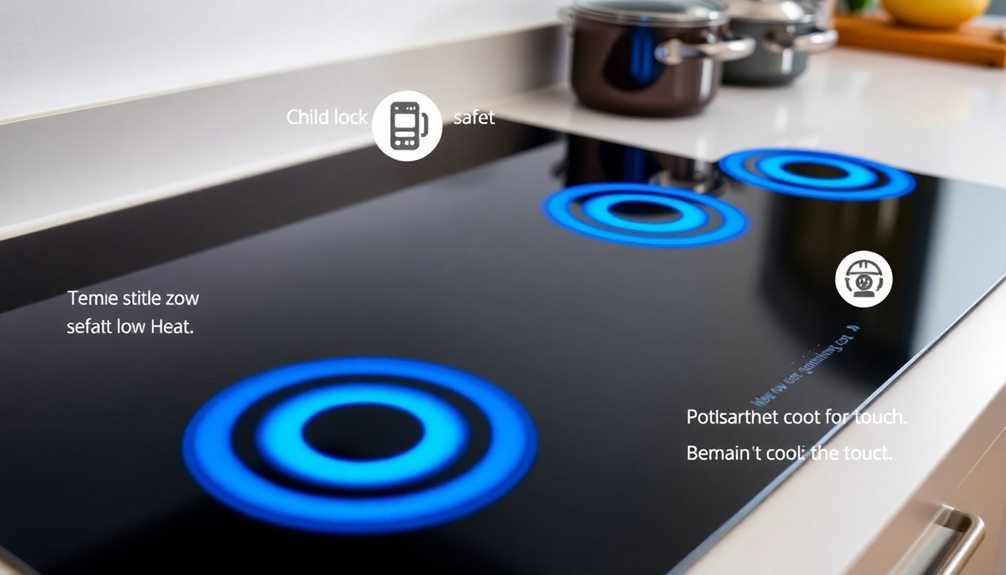
One of the standout advantages of induction cooktops is their impressive array of safety features that enhance your cooking experience.
These features not only protect you but also create a safer cooking environment overall. Here are three key safety aspects to take into account:
- Automatic Shut-Off Features: Induction cooktops automatically turn off when cookware is removed, preventing overheating and potential accidents.
- Child Lock Functions: Many models include child lock functions, guaranteeing that your cooktop can't be activated unintentionally by curious little hands.
- Incompatible Cookware Alerts: Induction cooktops alert you when you're using incompatible cookware, which prevents frustration and guarantees you're cooking efficiently.
Additionally, the cooktop surface remains cool to the touch, greatly reducing the risk of burns compared to traditional methods.
Plus, with less hot air released into the kitchen, you'll enjoy improved air quality during cooking.
These features collectively make induction cooktops a smart choice for safety-conscious cooks.
Whether you're preparing a simple meal or an elaborate feast, you can feel confident knowing that your cooking environment is designed with safety in mind.
Common Misconceptions About Induction
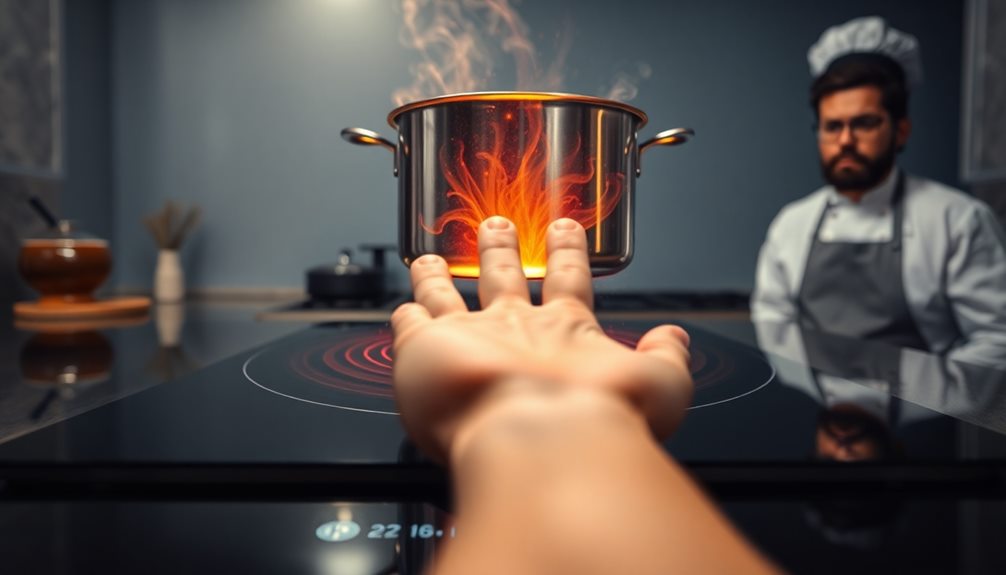
When it comes to induction cooktops, several misconceptions can lead to confusion and hesitation about using this innovative cooking technology. First off, many people think induction cooktops heat the surface itself, but they actually use electromagnetic energy to heat the cookware directly, keeping the cooktop cool to the touch. You might also believe that induction cooking is less efficient than gas, but it's up to 90% energy-efficient, while gas only reaches about 40%.
It's essential to know that not all cookware works on induction cooktops. Only ferrous materials, like cast iron and certain stainless steel, are compatible. Non-ferrous materials, such as aluminum and glass, won't work.
Another misconception is that induction cooktops are noisy. The sound typically comes from vibrations in the cookware rather than the cooktop itself, and it can vary based on the type of cookware you use. Finally, while you might think induction cooking is hard to master, many find that the rapid heating response and temperature control actually offer greater precision than traditional methods.
| Misconception | Reality |
|---|---|
| Induction heats the cooktop | It uses electromagnetic energy for cookware |
| Less efficient than gas | Up to 90% efficient, gas is 40% |
| Any cookware works | Only ferrous materials are compatible |
| Induction is noisy | Noise comes from cookware vibrations |
| Difficult to master | Offers greater precision |
Considerations When Switching to Induction
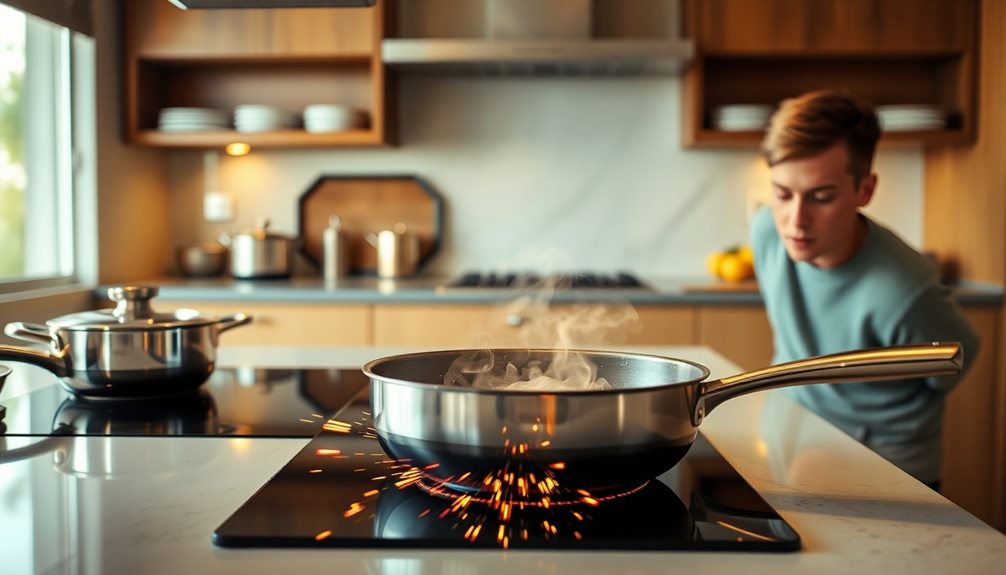
Switching to induction cooking can be an exciting change, but there are several important factors to keep in mind.
First and foremost, you need to verify that your pots and pans are compatible with induction cooktops. Only cookware made from magnetic materials, like cast iron and certain stainless steels, will work effectively.
Here are three key points to reflect on:
- Adjust Your Cooking Method: Induction cooking heats up faster than traditional methods, so you'll want to pre-prepare your ingredients to keep pace with the rapid heat energy.
- Ventilation Matters: While induction cooktops generate less hot air, it's still wise to install a hood vent. This helps capture any grease and maintain a comfortable cooking environment.
- Noise Awareness: Be prepared for some buzzing or humming noises from the electromagnetic field of the cooktop. This might be a distraction for some people.
Popular Induction Cooktop Models
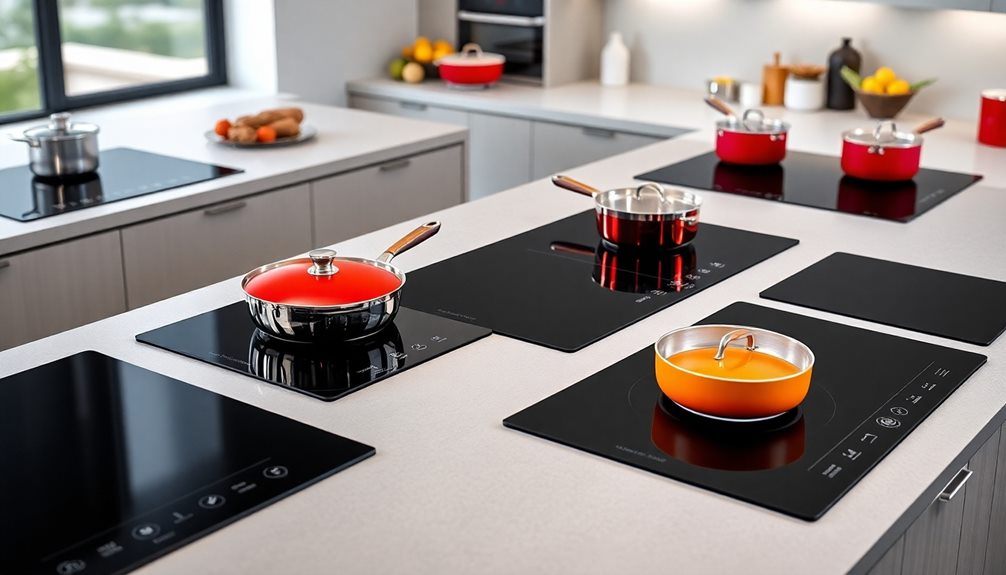
When you're exploring popular induction cooktop models, you'll find a range of top brands, each offering unique features that stand out.
For instance, Whirlpool and Bosch provide advanced settings and rapid boiling options, while GE and Frigidaire focus on energy efficiency and versatile cooking functions.
Let's compare these models to help you choose the best fit for your kitchen needs.
Top Brands Comparison
As you explore the world of induction cooktops, you'll find that popular brands like Whirlpool, Bosch, and GE each offer unique models tailored to different cooking needs.
Here's a quick comparison to help you decide:
1. Whirlpool: Known for its Griddle Zone feature, Whirlpool's induction cooktops allow you to cook multiple dishes simultaneously, making meal prep faster and more efficient.
2. Bosch: The Bosch 800 Series stands out with its multiple cooking zones and advanced features like SpeedBoost for rapid heating.
Plus, AutoChef guarantees consistent cooking results, perfect for those who prioritize precision.
3. GE: If you're into smart technology, GE's Profile series is worth considering. With WiFi connectivity, you can control and monitor your cooking from your smartphone, adding convenience to your culinary adventures.
These brands provide a variety of sizes and configurations, like 30-inch and 36-inch models, catering to various kitchen layouts and cooking preferences.
Whether you prioritize speed, technology, or versatility, there's an induction cooktop out there that fits your lifestyle perfectly.
Unique Features Overview
Induction cooktops boast a range of unique features that elevate your cooking experience. These innovative appliances utilize electromagnetic waves to generate heat directly in your cookware, guaranteeing rapid and efficient cooking.
With advanced touch controls, you can make precise temperature adjustments and set programmable cooking settings, enhancing both convenience and accuracy in your culinary endeavors. Additionally, the precise temperature control of induction cooktops can be likened to the importance of color accuracy in projector image quality, as both guarantee peak performance for the best results.
Popular models, like those from Whirlpool, often include a Griddle Zone that lets you cook multiple dishes at once, maximizing your efficiency in meal preparation. Some high-end induction cooktops even come equipped with a No Preheat Air Fry mode, allowing you to air fry instantly without the need for preheating, which cuts down on cooking time.
Another standout feature is auto-sizing pan detection, which automatically adjusts the heating area to fit the size of your cookware. This not only guarantees peak energy use but also prevents overheating.
Additionally, safety features such as automatic shut-off and child lock functions make these cooktops ideal for families, offering peace of mind while you cook. With these unique features, induction cooktops truly enhance your kitchen experience.
Frequently Asked Questions
What Is the Downside of Induction Stoves?
Induction stoves can be pricey, requiring compatible cookware and potential installation costs if converting from gas. You might also find the buzzing noise distracting and face a learning curve with their fast heating capabilities.
What Cannot Be Cooked on Induction?
Imagine a dance floor where only certain shoes can glide. You can't cook with non-magnetic cookware, warped cast iron, or traditional non-stick pans. If it doesn't fit, it won't cook well on induction.
Can You Touch an Induction Cooktop?
You can touch an induction cooktop, but be cautious. The surface stays cool when no cookware's present, yet the edges might still be warm. Always check and avoid touching immediately after cooking for safety.
What Is the Science Behind Induction Cooking?
Induction cooking's like magic—electricity flows through coils, creating a magnetic field that heats compatible cookware directly. This method's efficient, fast, and safe, keeping the surface cool while delivering heat right where you need it.
Conclusion
To sum up, induction cooking isn't just a trend; it's a game changer in the kitchen. You might think it's just another cooking method, but the efficiency and precision it offers can truly elevate your culinary skills. Plus, with its safety features and sleek design, it's hard to resist. So, if you're considering a switch, why not give induction a try? You may find it transforms not just how you cook, but also how you enjoy the process.



